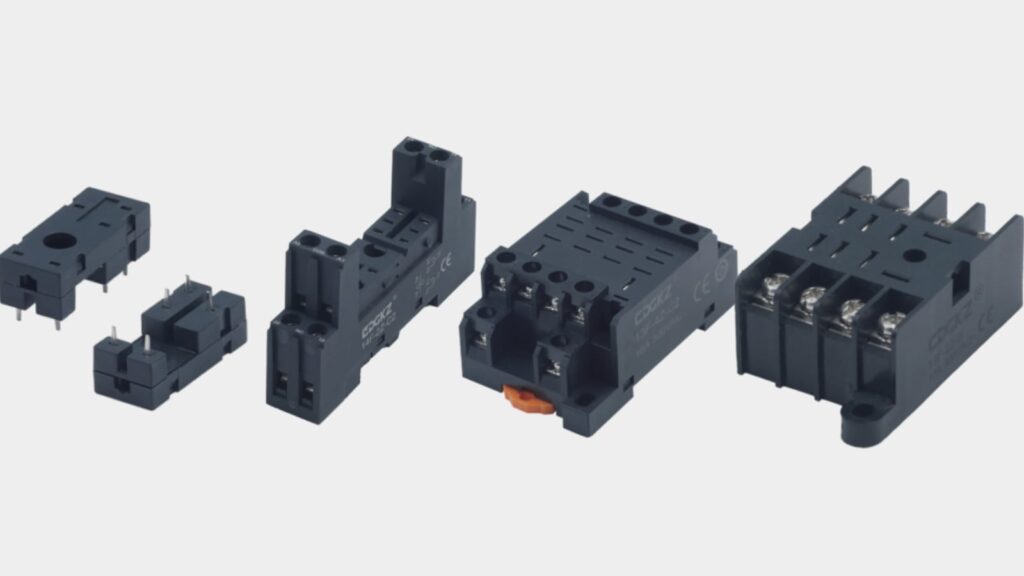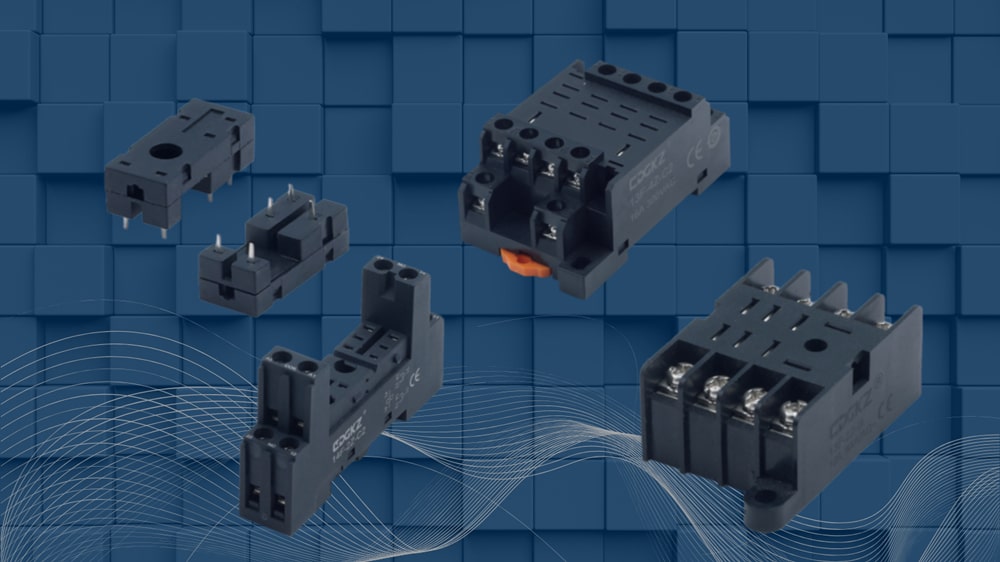Relay sockets are the unsung heroes behind countless control systems, quietly ensuring reliable connections between relays and circuits. As a key component in industrial automation, power control, and electrical panels, relay sockets simplify maintenance, boost efficiency, and enhance system flexibility.
With the rapid advancement of electrical engineering and automation technologies, the demand for versatile, high-performance relay sockets has skyrocketed. From compact PCB-mounted designs to rugged DIN rail-mounted options, relay socket types have evolved to suit a wide range of applications—whether you’re wiring up a smart factory or assembling a simple control box.
In this article, we’ll explore the different types of relay sockets, highlighting their unique features, use cases, and classifications based on mounting methods, connection types, voltage compatibility, and more.
Let’s dive right in and find out which relay socket is right for your project.
What is a Relay Socket?
A relay socket is an electrical component designed to hold and connect a relay to a circuit securely and efficiently. It acts as an interface between the relay and the electrical wiring, allowing for quick installation, easy replacement, and safe operation. Instead of soldering a relay directly into a circuit, a relay socket lets users plug in the relay—much like inserting a lightbulb into a socket.
Relay sockets come in various designs to support different relay types (such as electromagnetic relays, solid-state relays, and time-delay relays) and are available with multiple terminal configurations like screw, spring, or push-in connections. Common mounting styles include DIN rail mounting, panel mounting, and PCB mounting.
In industrial automation, power distribution systems, home appliances, and automotive applications, relay sockets improve system flexibility, reduce downtime during maintenance, and protect relays from heat and vibration. Simply put, a relay socket makes electrical systems more modular, serviceable, and reliable.
Types of Relay Sockets by Function

Relay sockets are not one-size-fits-all. Depending on the nature of the application and the performance requirements, relay sockets are categorized by function to ensure optimal performance and safety. Below are the main types of relay sockets classified according to their functional purpose:
1. General-Purpose Relay Sockets
These are the most commonly used relay sockets in standard electrical and automation systems. General-purpose relay sockets are designed for everyday circuit control tasks, such as switching lights, fans, motors, and basic automation processes. They support a wide range of relays and are typically compatible with DIN rail or panel mounting. Their versatility, affordability, and ease of installation make them ideal for commercial and residential control panels.
2. Time Relay Sockets
Time relay sockets are specifically designed to work with time delay relays—relays that operate after a preset delay. These sockets are essential in circuits where delayed activation or deactivation is required, such as in motor start sequences, lighting control, and HVAC systems. They help ensure accurate timing and simplify the setup of programmable delays. Time relay sockets often include markings or terminals tailored for time-setting features.
3. Power Relay Sockets
Designed to handle high voltages and heavy currents, power relay sockets are built for durability and heat resistance. They are typically used in industrial machinery, HVAC systems, and power distribution panels where high power loads need to be switched reliably. These sockets are made of flame-retardant materials and feature reinforced terminals to ensure a secure connection for high-amperage applications.
4. Signal Relay Sockets
For sensitive applications where small electrical signals control system responses—such as in telecommunications, measurement instruments, or low-power control logic—signal relay sockets are used. These are engineered to work with signal relays that operate at low voltage and low current. The design ensures minimal electrical interference and reliable signal transmission, which is crucial for precision electronics and data systems.
5. Control Relay Sockets
Control relay sockets are used in systems where the relay’s function is to control other relays or circuit paths. These sockets are commonly found in automation systems, building management systems, and programmable logic controller (PLC) setups. They offer easy wiring for relay control chains and help simplify complex multi-relay logic operations. Control relay sockets are often designed with multiple terminals to facilitate easy integration with sensors, controllers, or other relays.
Types of Relay Sockets by Application
Relay sockets are widely used across many industries, and their designs often reflect the specific needs of the application they serve. By categorizing relay sockets based on their application area, engineers can ensure optimal performance, durability, and safety in their systems. Below are the major types of relay sockets classified by application:
1. Industrial Relay Sockets
Industrial relay sockets are engineered to withstand harsh operating environments such as factories, manufacturing plants, and automation systems. These sockets are typically paired with high-performance industrial relays and are designed to handle heavy loads, high voltages, and continuous operation. They feature rugged construction, vibration resistance, and support for DIN rail mounting—making them ideal for PLC panels, conveyor systems, and industrial robotics.
2. Automotive Relay Sockets
Automotive relay sockets are used in vehicles to control functions like headlights, fuel pumps, engine control modules, and air conditioning systems. These sockets are compact, weather-resistant, and designed to operate reliably in environments exposed to temperature fluctuations, moisture, and vibration. Often used with blade-type relays, automotive relay sockets support quick replacement and secure connections in the limited space of vehicle fuse boxes.
3. Home Appliance Relay Sockets
In the consumer electronics and household appliance sector, home appliance relay sockets are used to support relays that control heating elements, motors, compressors, and digital interfaces. Applications include microwaves, washing machines, refrigerators, and air conditioners. These sockets are designed for compact installation, low-power switching, and long-term reliability, ensuring the smooth operation of home electronics.
4. Medical Equipment Relay Sockets
Medical relay sockets are used in devices where precision, safety, and reliability are critical. Found in equipment such as patient monitors, imaging systems, infusion pumps, and lab analyzers, these sockets are often designed to support low-noise, low-leakage relays with high isolation ratings. They meet strict regulatory standards for healthcare environments and are built with materials resistant to sterilization procedures and electromagnetic interference (EMI).
5. Telecommunication Equipment Relay Sockets
Used in network switches, data servers, base stations, and communication hubs, telecom relay sockets are built to support rapid signal switching and high-frequency data control. These sockets often work with miniature signal relays, designed for low current and voltage operation. Shielded housings, anti-interference materials, and space-saving designs are key features, ensuring stable operation in densely packed electronics environments.
Classification by Installation Method
Relay sockets are designed with various mounting options to suit different installation environments, space constraints, and system requirements. Selecting the right mounting style not only affects ease of installation but also impacts maintenance efficiency and system layout. Here are the main types of relay sockets based on their mounting method:
1. PCB Mount Relay Sockets
PCB (Printed Circuit Board) mount relay sockets are specifically designed to be soldered directly onto a printed circuit board. These sockets allow relays to be securely integrated into compact electronic assemblies. Common in consumer electronics, power supplies, control modules, and compact automation systems, PCB sockets are ideal for low to medium current applications. Their low profile and space-saving design make them perfect for embedded and densely populated circuit layouts.
2. DIN Rail Mount Relay Sockets
DIN rail mount relay sockets are the go-to choice for industrial automation and control systems. Designed to clip easily onto standard DIN rails, these sockets allow for quick installation and organized wiring inside control panels and electrical cabinets. They provide excellent accessibility for relay replacement and support high-current, high-voltage operations. DIN rail sockets are widely used in PLC systems, motor controllers, and industrial machinery due to their modular design and durability.
3. Universal Mount Relay Sockets
As the name suggests, universal mount relay sockets are built for flexibility. They support a wide variety of relay types and mounting methods, making them ideal for general-purpose applications. Whether you’re working on a prototyping project or need a reliable socket for small-scale production, universal sockets offer compatibility with multiple relay sizes, pin layouts, and terminal types. They can be used in both commercial and industrial environments, where adaptability and ease of integration are important.
How to Choose the Right Relay Socket for Your Project
Selecting the right relay socket isn’t just about matching shapes and pins—it’s a critical step that affects the performance, safety, and long-term reliability of your entire electrical or automation system. Here’s a practical guide to help you choose the ideal relay socket based on your project’s specific needs:
1. Define the Application Requirements
Start by understanding the function of the relay in your system. Are you switching high currents? Managing time delays? Controlling micro-signals? The relay’s function directly influences the type of socket required—whether it’s a power relay socket for heavy loads or a signal relay socket for low-current precision.
2. Check Relay Compatibility
Ensure that the socket is compatible with the physical size, pin configuration, and electrical ratings of the relay. Mismatches can lead to poor contact, overheating, or even system failure. Always refer to the datasheets of both the relay and the socket.
3. Choose the Right Mounting Style
Select a socket that fits your installation environment:
PCB Mount for compact boards and embedded systems
DIN Rail Mount for industrial panels and control cabinets
Universal Mount for flexible or general-purpose setups
Proper mounting reduces vibration, simplifies maintenance, and improves system organization.
4. Consider Environmental Conditions
Will the relay operate in a harsh industrial environment, a high-temperature zone, or outdoors? Choose sockets made from durable, heat-resistant, and flame-retardant materials if environmental stress is a factor. For automotive or medical applications, you may also need shock-proof or EMI-shielded sockets.
5. Evaluate Connection Type
The socket’s terminal type—screw, spring clamp, push-in, or solder—affects wiring efficiency and reliability. For example, spring clamps are faster to wire, while screw terminals are better for high-vibration environments.
6. Plan for Maintenance and Replacement
If the system requires frequent relay changes, use a socket that offers easy plug-in and pull-out design. Look for models with clear labeling, accessible terminals, and standardized mounting.
7. Factor in Standards and Certifications
For safety-critical projects, make sure the socket complies with UL, CE, RoHS, or other relevant certifications. This is especially important in medical, telecommunications, and industrial automation sectors.
CDGKZ: Provide High-Quality Relay Sockets for Each Project
After exploring all the information provided in this article, you’ve probably realized that relay socket types are incredibly diverse—each tailored for specific functions, environments, and industries. Choosing the right relay socket for your project can feel overwhelming, especially when you’re balancing performance, compatibility, safety, and cost.
Once you’ve identified the ideal socket type—whether it’s a DIN rail mount socket for industrial automation, a PCB socket for compact circuit boards, or a signal socket for sensitive applications—the next big question is: Where do you find reliable, high-quality relay sockets without overspending or compromising on performance?
That’s where CDGKZ comes in.
As an industry-leading manufacturer and supplier, CDGKZ offers a wide range of relay socket types to meet the demands of virtually any project. From general-purpose designs to specialized sockets for automotive, medical, and telecommunication applications, CDGKZ combines precision engineering, certified quality, and competitive pricing.
Plus, our experienced technical team is here to help you choose the most suitable socket, whether you’re building control panels, upgrading equipment, or developing high-end electronics.
Want to get a quote or learn more about our relay socket solutions?
Contact the CDGKZ team today—we’re ready to support your success.


